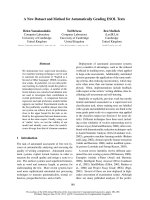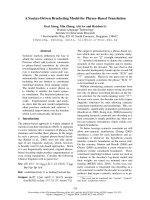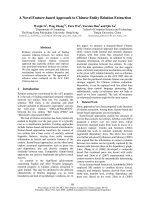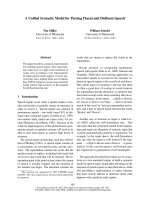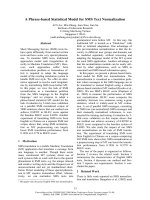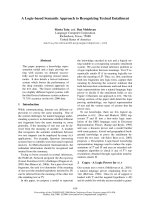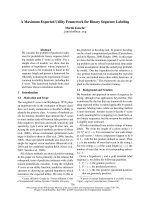Báo cáo khoa học: "A Graph-based Cross-lingual Projection Approach for Weakly Supervised Relation Extraction" pptx
Bạn đang xem bản rút gọn của tài liệu. Xem và tải ngay bản đầy đủ của tài liệu tại đây (160.21 KB, 6 trang )
Proceedings of the 50th Annual Meeting of the Association for Computational Linguistics, pages 48–53,
Jeju, Republic of Korea, 8-14 July 2012.
c
2012 Association for Computational Linguistics
A Graph-based Cross-lingual Projection Approach for
Weakly Supervised Relation Extraction
Seokhwan Kim
Human Language Technology Dept.
Institute for Infocomm Research
Singapore 138632
Gary Geunbae Lee
Dept. of Computer Science and Engineering
Pohang University of Science and Technology
Pohang, 790-784, Korea
Abstract
Although researchers have conducted exten-
sive studies on relation extraction in the last
decade, supervised approaches are still limited
because they require large amounts of training
data to achieve high performances. To build
a relation extractor without significant anno-
tation effort, we can exploit cross-lingual an-
notation projection, which leverages parallel
corpora as external resources for supervision.
This paper proposes a novel graph-based pro-
jection approach and demonstrates the mer-
its of it by using a Korean relation extrac-
tion system based on projected dataset from
an English-Korean parallel corpus.
1 Introduction
Relation extraction aims to identify semantic rela-
tions of entities in a document. Although many
supervised machine learning approaches have been
successfully applied to relation extraction tasks (Ze-
lenko et al., 2003; Kambhatla, 2004; Bunescu and
Mooney, 2005; Zhang et al., 2006), applications of
these approaches are still limited because they re-
quire a sufficient number of training examples to ob-
tain good extraction results. Several datasets that
provide manual annotations of semantic relation-
ships are available from MUC (Grishman and Sund-
heim, 1996) and ACE (Doddington et al., 2004)
projects, but these datasets contain labeled training
examples in only a few major languages, includ-
ing English, Chinese, and Arabic. Although these
datasets encourage the development of relation ex-
tractors for these major languages, there are few la-
beled training samples for learning new systems in
other languages, such as Korean. Because manual
annotation of semantic relations for such resource-
poor languages is very expensive, we instead con-
sider weakly supervised learning techniques (Riloff
and Jones, 1999; Agichtein and Gravano, 2000;
Zhang, 2004; Chen et al., 2006) to learn the rela-
tion extractors without significant annotation efforts.
But these techniques still face cost problems when
preparing quality seed examples, which plays a cru-
cial role in obtaining good extractions.
Recently, some researchers attempted to use ex-
ternal resources, such as treebank (Banko et al.,
2007) and Wikipedia (Wu and Weld, 2010), that
were not specially constructed for relation extraction
instead of using task-specific training or seed exam-
ples. We previously proposed to leverage parallel
corpora as a new kind of external resource for rela-
tion extraction (Kim et al., 2010). To obtain training
examples in the resource-poor target language, this
approach exploited a cross-lingual annotation pro-
jection by propagating annotations that were gener-
ated by a relation extraction system in a resource-
rich source language. In this approach, projected
annotations were determined in a single pass pro-
cess by considering only alignments between entity
candidates; we call this action direct projection.
In this paper, we propose a graph-based projec-
tion approach for weakly supervised relation extrac-
tion. This approach utilizes a graph that is con-
stucted with both instance and context information
and that is operated in an iterative manner. The goal
of our graph-based approach is to improve the ro-
bustness of the extractor with respect to errors that
are generated and accumulated by preprocessors.
48
f
E
(<Barack Obama, Honolulu>) = 1
f
K
( < Ú
Ó zj , ŽÖF> > ) = 1
ÚÓ zj
(beo-rak-o-ba-ma)
&r
(e-seo)
ê
(neun)
ŽÖF>
(ho-nol-rul-ru)
®–Ê
(ha-wa-i)
2:.
(tae-eo-nat-da)
®
(ui)
Barack Obama was born in Honolulu Hawaii, .
(
beo-rak-o-ba-ma)
(ho-nol-rul-ru)
Figure 1: An example of annotation projection for rela-
tion extraction of a bitext in English and Korean
2 Cross-lingual Annotation Projection for
Relation Extraction
Relation extraction can be considered to be a classi-
fication problem by the following classifier:
f
e
i
, e
j
=
1 if e
i
and e
j
have a relation,
−1 otherwise.
,
where e
i
and e
j
are entities in a sentence.
Cross-lingual annotation projection intends to
learn an extractor f
t
for good performance with-
out significant effort toward building resources for
a resource-poor target language L
t
. To accomplish
that goal, the method automatically creates a set of
annotated text for f
t
, utilizing a well-made extractor
f
s
for a resource-rich source language L
s
and a par-
allel corpus of L
s
and L
t
. Figure 1 shows an exam-
ple of annotation projection for relation extraction
with a bi-text in L
t
Korean and L
s
English. Given an
English sentence, an instance Barack Obama, Hon-
olulu is extracted as positive. Then, its translational
counterpart beo-rak-o-ba-ma, ho-nol-rul-ru in the
Korean sentence also has a positive annotation by
projection.
Early studies in cross-lingual annotation projec-
tion were accomplished for various natural lan-
guage processing tasks (Yarowsky and Ngai, 2001;
Yarowsky et al., 2001; Hwa et al., 2005; Zitouni and
Florian, 2008; Pado and Lapata, 2009). These stud-
ies adopted a simple direct projection strategy that
propagates the annotations in the source language
sentences to word-aligned target sentences, and a
target system can bootstrap from these projected an-
notations.
For relation extraction, the direct projection strat-
egy can be formularized as follows: f
t
e
i
t
, e
j
t
=
f
s
A(e
i
t
), A(e
j
t
)
, where A(e
t
) is the aligned entity
of e
t
. However, these automatic annotations can be
unreliable because of source text mis-classification
and word alignment errors; thus, it can cause a criti-
cal falling-off in the annotation projection quality.
Although some noise reduction strategies for pro-
jecting semantic relations were proposed (Kim et al.,
2010), the direct projection approach is still vulner-
able to erroneous inputs generated by submodules.
We note two main causes for this limitation: (1)
the direct projection approach considers only align-
ments between entity candidates, and it does not
consider any contextual information; and, (2) it is
performed by a single pass process. To solve both of
these problems at once, we propose a graph-based
projection approach for relation extraction.
3 Graph Construction
The most crucial factor in the success of graph-
based learning approaches is how to construct a
graph that is appropriate for the target task. Das
and Petrov (Das and Petrov, 2011) proposed a graph-
based bilingual projection of part-of-speech tagging
by considering the tagged words in the source lan-
guage as labeled examples and connecting them to
the unlabeled words in the target language, while re-
ferring to the word alignments. Graph construction
for projecting semantic relationships is more com-
plicated than part-of-speech tagging because the unit
instance of projection is a pair of entities and not a
word or morpheme that is equivalent to the align-
ment unit.
3.1 Graph Vertices
To construct a graph for a relation projection, we
define two types of vertices: instance vertices V and
context vertices U.
Instance vertices are defined for all pairs of en-
tity candidates in the source and target languages.
Each instance vertex has a soft label vector Y =
[ y
+
y
−
], which contains the probabilities that
the instance is positive or negative, respectively. The
larger the y
+
value, the more likely the instance has
a semantic relationship. The initial label values of an
instance vertex v
ij
s
∈ V
s
for the instance
e
i
s
, e
j
s
in
the source language are assigned based on the con-
fidence score of the extractor f
s
. With respect to the
target language, every instance vertex v
ij
t
∈ V
t
has
49
the same initial values of 0.5 in both y
+
and y
−
.
The other type of vertices, context vertices, are
used for identifying relation descriptors that are con-
textual subtexts that represent semantic relationships
of the positive instances. Because the characteristics
of these descriptive contexts vary depending on the
language, context vertices should be defined to be
language-specific. In the case of English, we define
the context vertex for each trigram that is located be-
tween a given entity pair that is semantically related.
If the context vertices U
s
for the source language
sentences are defined, then the units of context in
the target language can also be created based on the
word alignments. The aligned counterpart of each
source language context vertex is used for generat-
ing a context vertex u
i
t
∈ U
t
in the target language.
Each context vertex u
s
∈ U
s
and u
t
∈ U
t
also has
y
+
and y
−
, which represent how likely the context
is to denote semantic relationships. The probability
values for all of the context vertices in both of the
languages are initially assigned to y
+
= y
−
= 0.5.
3.2 Edge Weights
The graph for our graph-based projection is con-
structed by connecting related vertex pairs by
weighted edges. If a given pair of vertices is likely to
have the same label, then the edge connecting these
vertices should have a large weight value.
We define three types of edges according to com-
binations of connected vertices. The first type of
edges consists of connections between an instance
vertex and a context vertex in the same language.
For a pair of an instance vertex v
i,j
and a context
vertex u
k
, these vertices are connected if the context
sequence of v
i,j
contains u
k
as a subsequence. If
v
ij
is matched to u
k
, the edge weight w
v
i,j
, u
k
)
is assigned to 1. Otherwise, it should be 0.
Another edge category is for the pairs of context
vertices in a language. Because each context vertex
is considered to be an n-gram pattern in our work,
the weight value for each edge of this type represents
the pattern similarity between two context vertices.
The edge weight w(u
k
, u
l
) is computed by Jaccard’s
coefficient between u
k
and u
l
.
While the previous two categories of edges are
concerned with monolingual connections, the other
type addresses bilingual alignments of context ver-
tices between the source language and the target lan-
guage. We define the weight for a bilingual edge
connecting u
k
s
and u
l
t
as the relative frequency of
alignments, as follows:
w(u
k
s
, u
l
t
) = count
u
k
s
, u
l
t
/
u
m
t
count
u
k
s
, u
m
t
,
where count (u
s
, u
t
) is the number of alignments
between u
s
and u
t
across the whole parallel corpus.
4 Label Propagation
To induce labels for all of the unlabeled vertices on
the graph constructed in Section 3, we utilize the
label propagation algorithm (Zhu and Ghahramani,
2002), which is a graph-based semi-supervised
learning algorithm.
First, we construct an n × n matrix T that rep-
resents transition probabilities for all of the vertex
pairs. After assigning all of the values on the ma-
trix, we normalize the matrix for each row, to make
the element values be probabilities. The other input
to the algorithm is an n × 2 matrix Y , which indi-
cates the probabilities of whether a given vertex v
i
is
positive or not. The matrix T and Y are initialized
by the values described in Section 3.
For the input matrices T and Y , label propagation
is performed by multiplying the two matrices, to up-
date the Y matrix. This multiplication is repeated
until Y converges or until the number of iterations
exceeds a specific number. The Y matrix, after fin-
ishing its iterations, is considered to be the result of
the algorithm.
5 Implementation
To demonstrate the effectiveness of the graph-based
projection approach for relation extraction, we de-
veloped a Korean relation extraction system that was
trained with projected annotations from English re-
sources. We used an English-Korean parallel cor-
pus
1
that contains 266,892 bi-sentence pairs in En-
glish and Korean. We obtained 155,409 positive in-
stances from the English sentences using an off-the-
shelf relation extraction system, ReVerb
2
(Fader et
al., 2011).
1
The parallel corpus collected is available in our website:
/>2
/>50
Table 1: Comparison between direct and graph-based
projection approaches to extract semantic relationships
for four relation types
Type
Direct Graph-based
P R F P R F
Acquisition 51.6 87.7 64.9 55.3 91.2 68.9
Birthplace 69.8 84.5 76.4 73.8 87.3 80.0
Inventor Of 62.4 85.3 72.1 66.3 89.7 76.3
Won Prize 73.3 80.5 76.7 76.4 82.9 79.5
Total 63.9 84.2 72.7 67.7 87.4 76.3
The English sentence annotations in the parallel
corpus were then propagated into the correspond-
ing Korean sentences. We used the GIZA++ soft-
ware
3
(Och and Ney, 2003) to obtain the word align-
ments for each bi-sentence in the parallel corpus.
The graph-based projection was performed by the
Junto toolkit
4
with the maximum number of itera-
tions of 10 for each execution.
Projected instances were utilized as training ex-
amples to learn the Korean relation extractor. We
built a tree kernel-based support vector machine
model using SVM-Light
5
(Joachims, 1998) and
Tree Kernel tools
6
(Moschitti, 2006). In our model,
we adopted the subtree kernel method for the short-
est path dependency kernel (Bunescu and Mooney,
2005).
6 Evaluation
The experiments were performed on the manu-
ally annotated Korean test dataset. The dataset
was built following the approach of Bunescu and
Mooney (Bunescu and Mooney, 2007). The dataset
consists of 500 sentences for four relation types: Ac-
quisition, Birthplace, Inventor of, and Won Prize. Of
these, 278 sentences were annotated as positive in-
stances.
The first experiment aimed to compare two sys-
tems constructed by the direct projection (Kim et al.,
2010) and graph-based projection approach. Table 1
shows the performances of the relation extraction of
the two systems. The graph-based system achieved
better performances in precision and recall than the
3
/>4
/>5
/>6
moschitt/Tree-Kernel.htm
Table 2: Comparisons of our projection approach to
heuristic and Wikipedia-based approaches
Approach P R F
Heuristic-based 92.31 17.27 29.09
Wikipedia-based 66.67 66.91 66.79
Projection-based 67.69 87.41 76.30
system with direct projection for all of the four re-
lation types. It outperformed the baseline system by
an F-measure of 3.63.
To demonstrate the merits of our work against
other approaches based on monolingual external re-
sources, we performed comparisons with the fol-
lowing two baselines: heuristic-based (Banko et
al., 2007) and Wikipedia-based approaches (Wu and
Weld, 2010). The heuristic-based baseline was built
on the Sejong treebank corpus (Kim, 2006) and the
Wikipedia-based baseline used Korean Wikipedia
articles
7
. Table 2 compares the performances of the
two baseline systems and our method. Our proposed
projection-based approach obtained better perfor-
mance than the other systems. It outperformed the
heuristic-based system by 47.21 and the Wikipedia-
based system by 9.51 in the F-measure.
7 Conclusions
This paper presented a novel graph-based projection
approach for relation extraction. Our approach per-
formed a label propagation algorithm on a proposed
graph that represented the instance and context fea-
tures of both the source and target languages. The
feasibility of our approach was demonstrated by our
Korean relation extraction system. Experimental re-
sults show that our graph-based projection helped to
improve the performance of the cross-lingual anno-
tation projection of the semantic relations, and our
system outperforms the other systems, which incor-
porate monolingual external resources.
In this work, we operated the graph-based pro-
jection under very restricted conditions, because of
high complexity of the algorithm. For future work,
we plan to relieve the complexity problem for deal-
ing with more expanded graph structure to improve
the performance of our proposed approach.
7
We used the Korean Wikipedia database dump as of June
2011.
51
Acknowledgments
This research was supported by the MKE(The
Ministry of Knowledge Economy), Korea, un-
der the ITRC(Information Technology Research
Center) support program (NIPA-2012-(H0301-12-
3001)) supervised by the NIPA(National IT Industry
Promotion Agency) and Industrial Strategic technol-
ogy development program, 10035252, development
of dialog-based spontaneous speech interface tech-
nology on mobile platform, funded by the Ministry
of Knowledge Economy(MKE, Korea).
References
E. Agichtein and L. Gravano. 2000. Snowball: Ex-
tracting relations from large plain-text collections. In
Proceedings of the fifth ACM conference on Digital li-
braries, pages 85–94.
M. Banko, M. J Cafarella, S. Soderland, M. Broadhead,
and O. Etzioni. 2007. Open information extrac-
tion from the web. In Proceedings of the 20th In-
ternational Joint Conference on Artificial Intelligence,
pages 2670–2676.
R. Bunescu and R. Mooney. 2005. A shortest path de-
pendency kernel for relation extraction. In Proceed-
ings of the conference on Human Language Technol-
ogy and Empirical Methods in Natural Language Pro-
cessing, pages 724–731.
R. Bunescu and R. Mooney. 2007. Learning to extract
relations from the web using minimal supervision. In
Proceedings of the 45th annual meeting of the Associ-
ation for Computational Linguistics, volume 45, pages
576–583.
J. Chen, D. Ji, C. L Tan, and Z. Niu. 2006. Relation ex-
traction using label propagation based semi-supervised
learning. In Proceedings of the 21st International
Conference on Computational Linguistics and the 44th
annual meeting of the Association for Computational
Linguistics, pages 129–136.
D. Das and S. Petrov. 2011. Unsupervised part-of-
speech tagging with bilingual graph-based projections.
In Proceedings of the 49th Annual Meeting of the As-
sociation for Computational Linguistics: Human Lan-
guage Technologies, pages 600–609.
G. Doddington, A. Mitchell, M. Przybocki, L. Ramshaw,
S. Strassel, and R. Weischedel. 2004. The auto-
matic content extraction (ACE) program–tasks, data,
and evaluation. In Proceedings of LREC, volume 4,
pages 837–840.
A. Fader, S. Soderland, and O. Etzioni. 2011. Identify-
ing relations for open information extraction. In Pro-
ceedings of the Conference on Empirical Methods in
Natural Language Processing, pages 1535–1545.
R. Grishman and B. Sundheim. 1996. Message under-
standing conference-6: A brief history. In Proceedings
of the 16th conference on Computational linguistics,
volume 1, pages 466–471.
R. Hwa, P. Resnik, A. Weinberg, C. Cabezas, and O. Ko-
lak. 2005. Bootstrapping parsers via syntactic projec-
tion across parallel texts. Natural language engineer-
ing, 11(3):311–325.
T. Joachims. 1998. Text categorization with support vec-
tor machines: Learning with many relevant features.
In Proceedings of the European Conference on Ma-
chine Learning, pages 137–142.
N. Kambhatla. 2004. Combining lexical, syntactic,
and semantic features with maximum entropy mod-
els for extracting relations. In Proceedings of the
ACL 2004 on Interactive poster and demonstration
sessions, pages 22–25.
S. Kim, M. Jeong, J. Lee, and G. G Lee. 2010. A cross-
lingual annotation projection approach for relation de-
tection. In Proceedings of the 23rd International Con-
ference on Computational Linguistics, pages 564–571.
H. Kim. 2006. Korean national corpus in the 21st cen-
tury sejong project. In Proceedings of the 13th NIJL
International Symposium, pages 49–54.
A. Moschitti. 2006. Making tree kernels practical for
natural language learning. In Proceedings of the 11th
Conference of the European Chapter of the Associa-
tion for Computational Linguistics, volume 6, pages
113–120.
F. J Och and H. Ney. 2003. A systematic comparison of
various statistical alignment models. Computational
linguistics, 29(1):19–51.
S. Pado and M. Lapata. 2009. Cross-lingual annotation
projection of semantic roles. Journal of Artificial In-
telligence Research, 36(1):307–340.
E. Riloff and R. Jones. 1999. Learning dictionaries for
information extraction by multi-level bootstrapping.
In Proceedings of the National Conference on Artifi-
cial Intelligence, pages 474–479.
F. Wu and D. Weld. 2010. Open information extraction
using wikipedia. In Proceedings of the 48th Annual
Meeting of the Association for Computational Linguis-
tics, pages 118–127.
D. Yarowsky and G. Ngai. 2001. Inducing multilingual
POS taggers and NP bracketers via robust projection
across aligned corpora. In Proceedings of the Second
Meeting of the North American Chapter of the Associ-
ation for Computational Linguistics, pages 1–8.
D. Yarowsky, G. Ngai, and R. Wicentowski. 2001. In-
ducing multilingual text analysis tools via robust pro-
jection across aligned corpora. In Proceedings of the
52
First International Conference on Human Language
Technology Research, pages 1–8.
D. Zelenko, C. Aone, and A. Richardella. 2003. Kernel
methods for relation extraction. The Journal of Ma-
chine Learning Research, 3:1083–1106.
M. Zhang, J. Zhang, J. Su, and G. Zhou. 2006. A com-
posite kernel to extract relations between entities with
both flat and structured features. In Proceedings of the
21st International Conference on Computational Lin-
guistics and the 44th annual meeting of the Associa-
tion for Computational Linguistics, pages 825–832.
Z. Zhang. 2004. Weakly-supervised relation classifica-
tion for information extraction. In Proceedings of the
thirteenth ACM international conference on Informa-
tion and knowledge management, pages 581–588.
X. Zhu and Z. Ghahramani. 2002. Learning from labeled
and unlabeled data with label propagation. School
Comput. Sci., Carnegie Mellon Univ., Pittsburgh, PA,
Tech. Rep. CMU-CALD-02-107.
I. Zitouni and R. Florian. 2008. Mention detection cross-
ing the language barrier. In Proceedings of the Confer-
ence on Empirical Methods in Natural Language Pro-
cessing, pages 600–609.
53

